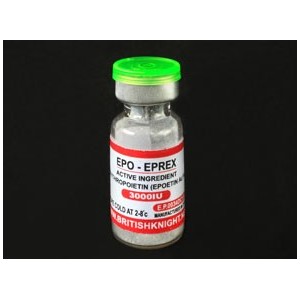Description
Type: injectable
Pack: 1 vial of 10,000iu
Substance : Erythropoietin alpha
Manufacturer: Bio Sidus S.A., Argentina
HEMAX contains recombinant human erythropoietin alfa (rHuEPO) as the active ingredient. rHuEPO is a glycoprotein of 165 amino acids, of recombinant origin, obtained from a genetically modified mammalian cell. EPO HEMAX is of maximum purity and cannot be differentiated from natural human erythropoietin.
rHuEPO is indicated for the treatment of anemia secondary to renal failure including patients on hemodialysis or peritoneal dialysis. Treatment with rHuEPO increases the level of hematocrit and hemoglobin, thereby reducing the transfusion requirements of patients. Before the start of treatment, other causes that can aggravate patients' anemia must be eliminated, especially iron deficiency. Subsequently, iron metabolism analyzes should be done including an analysis of the amount of iron in the blood (transferrin saturation, serum ferritin). It is suggested that patients have a transferrin saturation above 20% or more than 100 µg/dl ferritin before starting treatment. Iron level should be assessed during treatment.
Dosage: 50 U/kg/day, 3 times a week by IV route
Microdosing: 1000iu per day.
Once the expected hematocrit is reached, the dose can be reduced by 30% by switching to the S.C route, if the patient has started treatment by the I.V route.
The use of the subcutaneous route is recommended.
Contraindications:
– Hemax is contraindicated in case of uncontrolled arterial hypertension,
– Hypersensitivity to human albumin,
– Hypersensitivity to products derived from mammalian cell lines.
– Erythroblastopenia following treatment with arythropoietin.
Blood pressure should be strictly monitored before and during treatment. Epoetin should be administered with caution to patients with a history of seizures.
Elimination of intravenously administered rHuEPO follows first-order kinetics.
The half-life of rHuEPO in patients with renal insufficiency is 4 to 13 hours.
In general, the plasma level of erythropoietin returns to its basal level after 24 h.
The maximum concentration of the drug is observed between 5 to 24 hours after subcutaneous administration and its decline is very strong.
In healthy adults, the half-life after intravenous administration is 20% lower than that of patients with renal insufficiency.
Used in therapy for the treatment of anemia, its 'ingestion' allows a healthy individual to increase the number of his red blood cells and therefore his ability to transport oxygen to the muscles. We understand the major interest that this hormone can have for endurance specialties.
In 1987, even before being put on the market (period of clinical experiments), when it had just been synthesized by genetic engineering of the natural hormone, EPO appeared in the world of sports. high level.
Since that date and until today, EPO has been acclaimed by athletes practicing endurance activities. This enthusiasm is explained by an effectiveness felt by athletes ('feeling of having a turbo') and proven by numerous scientific experiments.
The Swedish doctor, Bjorn Ekblom, the very one who had put at least the technique of autotransfusion, was one of the first scientists to prove the effectiveness of EPO.The improvement found in terms of performance was around 10% in three weeks. Since then, this figure has been confirmed several times. After 6 weeks of treatment, the increase in oxygen consumption would be 8% and that of performance by 16%.
The famous Ekblom even went so far as to compare the use of EPO with autotransfusion to find that in both cases the increase in VO2max is comparable.
Even if this is indeed the case, the use of EPO has multiple advantages over autotransfusion:
the injection methodology is infinitely simpler
the injections can be repeated at controlled intervals and adapted according to the reactions of the athlete.
the hormone disappears rapidly from the blood (within 48 hours the levels have returned to normal) while its effects last for several weeks. It should be noted that this simple observation makes any attempt at direct blood control during competitions meaningless.
These prerogatives have contributed to making EPO the product of long-term sports. According to some specialists, it is the entire training process that would be managed from EPO and the evolution of the level of red blood cells that it generates. In an average subject, the hematocrit rate (% expressing the concentration of red blood cells in the blood) is in a range between 40 and 50% (a little less for a woman). A first period of taking EPO brings this rate to around 50-55%. Training of the long outing type at moderate speeds is carried out in conjunction. In a second step, taking EPO brings the hematocrit to around 55-60%, interval training can then give its full measure.
If we resume our planning of the perfect driver, we obtain a program of the type:
period 1: anabolic products
period 2: corticosteroids
period 3: growth hormone and IGF-1
period 4: EPO
Of course all the variations are possible, all the 'cocktails' are possible around this uncertain base.
But back to EPO. Here again, as it is a hormone, its use is not without danger for the athlete.
First of all, note that its intake must be coupled with that of iron which enters into the composition of hemoglobin (the oxygen-carrying pigment) contained in red blood cells. Since the doses are given empirically (not to say eccentric) many cases of iron overdose have been detected. Overdosed runners risk numerous cell lesions (cirrhosis, diabetes, heart attacks, etc.).
Furthermore, EPO can lead to embolisms. If injected too quickly, it can cause a flu syndrome with fever, chills, muscle pain….
Consult us before ordering this product.



Reviews
There are no reviews yet.